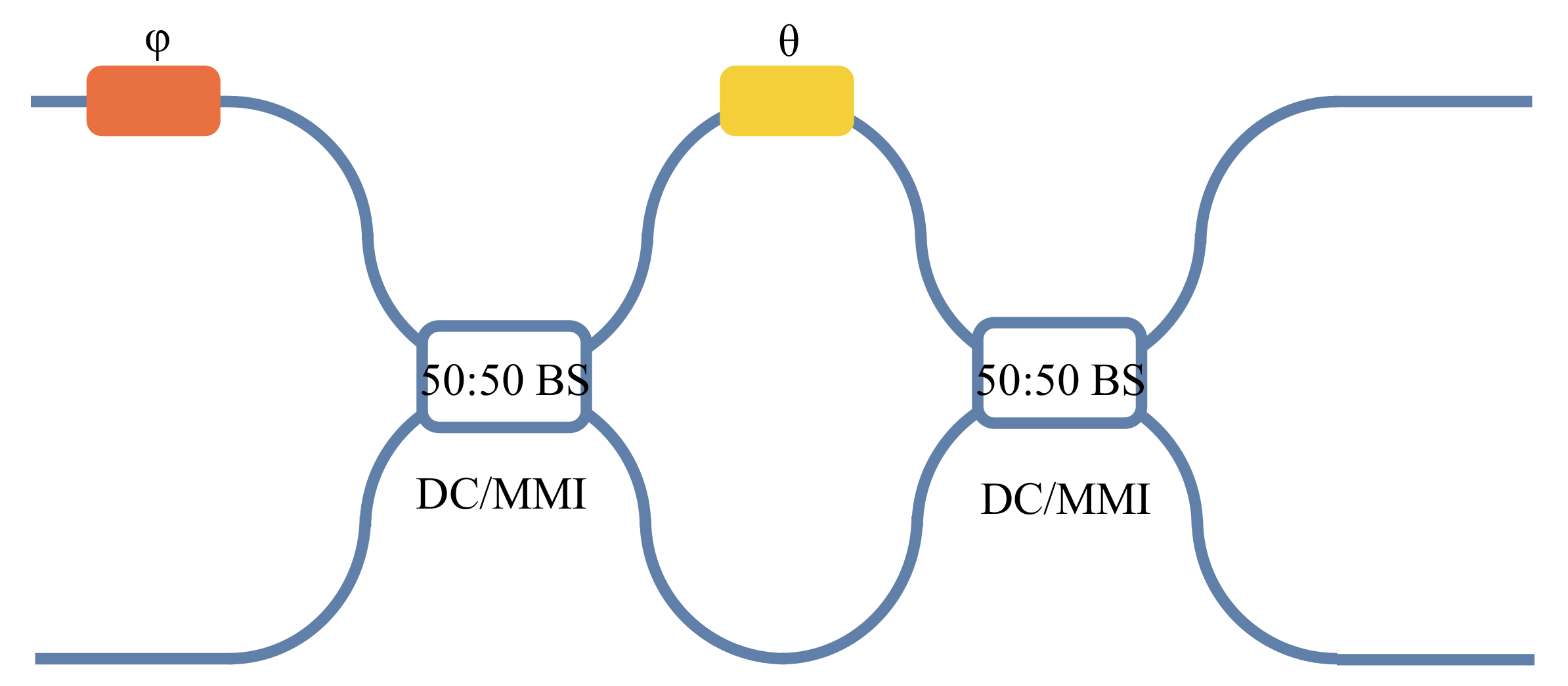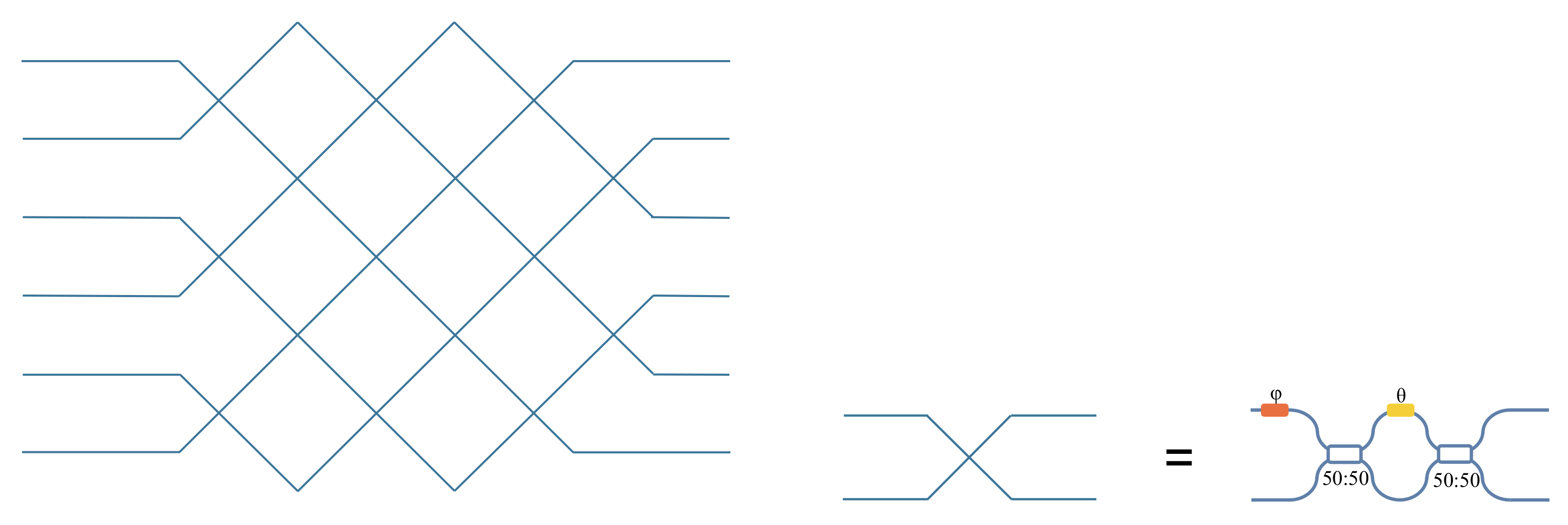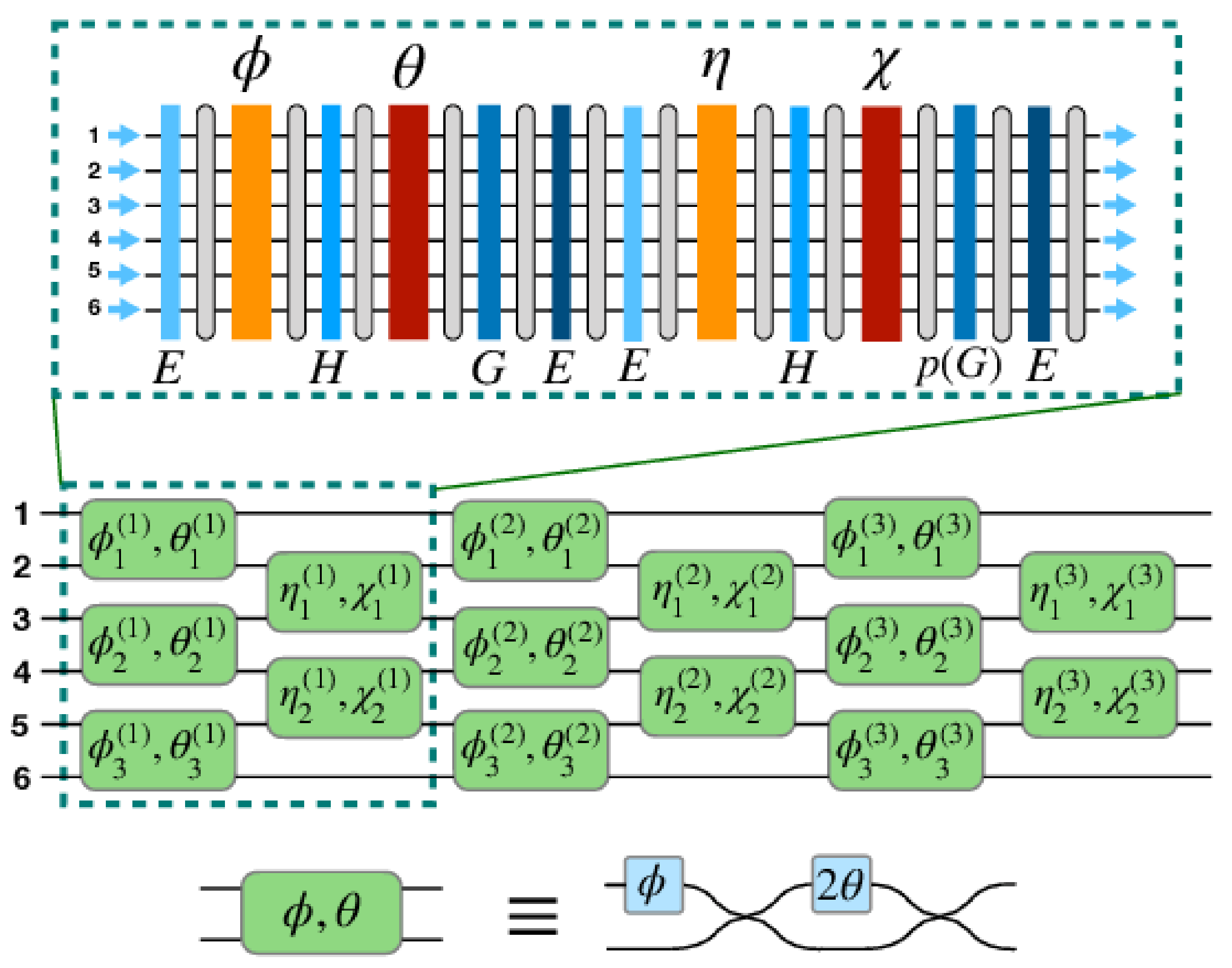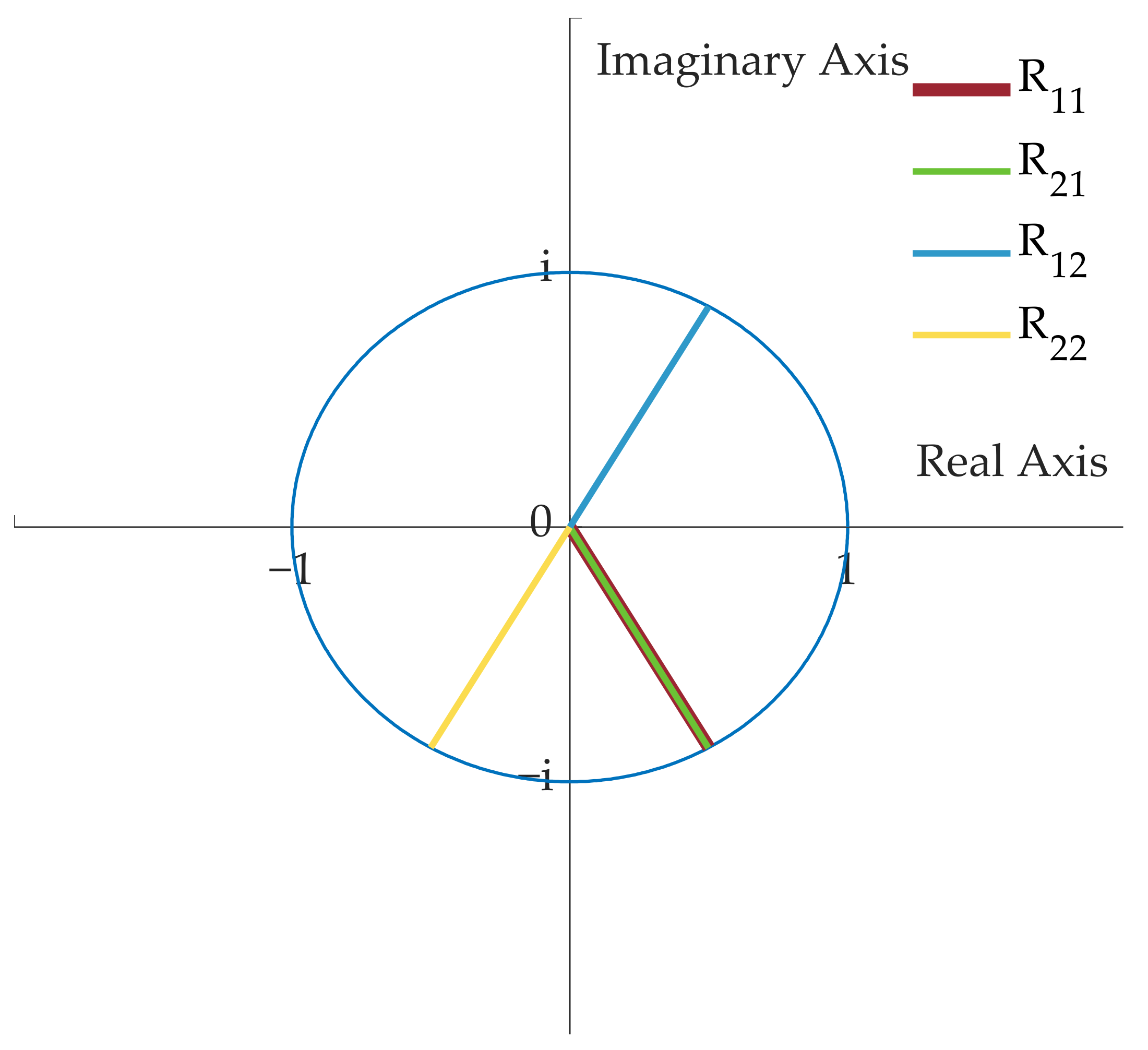Hardware Error Correction for MZI-Based Matrix Computation
Abstract
:1. Introduction
2. Methods
3. Hardware Error
4. Error Correction
4.1. The Entire MZI Meshes
4.1.1. Rectangular Mesh
4.1.2. Fourier Structure
4.1.3. Redundant Rectangular Mesh
4.2. A Single MZI Device
5. Discussion
6. Conclusions
Author Contributions
Funding
Institutional Review Board Statement
Informed Consent Statement
Data Availability Statement
Acknowledgments
Conflicts of Interest
References
- Zhou, Z. Silicon Based Optoelectronics, 2nd ed.; Science Press: Beijing, China, 2021; pp. 430–447. [Google Scholar]
- Zhou, Z.; Xu, P.; Dong, X. Computing on Silicon Photonic Platform. Chin. J. Lasers 2020, 47, 0600001. [Google Scholar] [CrossRef]
- Xu, P.; Zhou, Z. Silicon-based optoelectronics for general-purpose matrix computation: A review. Adv. Photonics 2022, 4, 044001. [Google Scholar] [CrossRef]
- Carolan, J.; Harrold, C.; Sparrow, C.; Martín-López, E.; Russell, N.J.; Silverstone, J.W.; Shadbolt, P.J.; Matsuda, N.; Oguma, M.; Itoh, M.; et al. Universal linear optics. Science 2015, 349, 711–716. [Google Scholar] [CrossRef] [PubMed]
- Bogaerts, W.; Pérez, D.; Capmany, J.; Miller, D.A.B.; Poon, J.; Englund, D.; Morichetti, F.; Melloni, A. Programmable photonic circuits. Nature 2020, 586, 207–216. [Google Scholar] [CrossRef]
- Pérez-López, D.; López, A.; DasMahapatra, P.; Capmany, J. Multipurpose self-configuration of programmable photonic circuits. Nat. Commun. 2020, 11, 6359. [Google Scholar] [CrossRef] [PubMed]
- Dong, M.; Clark, G.; Leenheer, A.J.; Zimmermann, M.; Dominguez, D.; Menssen, A.J.; Heim, D.; Gilbert, G.; Englund, D.; Eichenfield, M. High-speed programmable photonic circuits in a cryogenically compatible, visible–near-infrared 200 mm CMOS architecture. Nat. Photonics 2022, 16, 59–65. [Google Scholar] [CrossRef]
- Enomoto, Y.; Yonezu, K.; Mitsuhashi, Y.; Takase, K.; Takeda, S. Programmable and sequential Gaussian gates in a loop-based single-mode photonic quantum processor. Sci. Adv. 2021, 7, j6624. [Google Scholar] [CrossRef]
- Fu, T.; Zang, Y.; Huang, Y.; Du, Z.; Huang, H.; Hu, C.; Chen, M.; Yang, S.; Chen, H. Photonic machine learning with on-chip diffractive optics. Nat. Commun. 2023, 14, 70. [Google Scholar] [CrossRef]
- Bogaerts, W.; Chrostowski, L. Silicon Photonics Circuit Design: Methods, Tools and Challenges. Laser Photonics Rev. 2018, 12, 1700237. [Google Scholar] [CrossRef]
- Boeuf, F.; Cremer, S.; Temporiti, E.; Fere, M.; Shaw, M.; Vulliet, N.; Orlando, B.; Ristoiu, D.; Farcy, A.; Pinguet, T.; et al. Recent progress in silicon photonics R and D and manufacturing on 300mm wafer platform. In Proceedings of the 2015 Optical Fiber Communications Conference and Exhibition (OFC), Los Angeles, CA, USA, 22–26 March 2015. [Google Scholar]
- Zhou, H.; Dong, J.; Cheng, J.; Dong, W.; Huang, C.; Shen, Y.; Zhang, Q.; Gu, M.; Qian, C.; Chen, H.; et al. Photonic matrix multiplication lights up photonic accelerator and beyond. Light. Sci. Appl. 2022, 11, 30. [Google Scholar] [CrossRef]
- Du, Y.; Su, K.; Yuan, X.; Li, T.; Liu, K.; Man, H.; Zou, X. Implementation of optical neural network based on Mach–Zehnder interferometer array. Iet Optoelectron. 2023, 17, 1–11. [Google Scholar] [CrossRef]
- Jacques, M.; Samani, A.; El-Fiky, E.; Patel, D.; Xing, Z.; Plant, D.V. Optimization of thermo-optic phase-shifter design and mitigation of thermal crosstalk on the soi platform. Opt. Express 2019, 27, 10456. [Google Scholar] [CrossRef] [PubMed]
- AlTaha, M.W. Automatic Tuning Circuits for Mach-Zehnder Interferometer Optical Switches; University of British Columbia: Vancouver, BC, Canada, 2017. [Google Scholar] [CrossRef]
- Zhang, Y.; Ashe, J.J. Designing a High-Performance Tec Controller; SPIE: Washington, DC, USA, 2002; Volume 4913, pp. 177–183. [Google Scholar] [CrossRef]
- Shastri, B.J.; Tait, A.N.; Ferreira De Lima, T.; Pernice, W.H.P.; Bhaskaran, H.; Wright, C.D.; Prucnal, P.R. Photonics for artificial intelligence and neuromorphic computing. Nat. Photonics 2021, 15, 102–114. [Google Scholar] [CrossRef]
- Xie, Y.; Shi, Y.; Liu, L.; Wang, J.; Priti, R.; Zhang, G.; Liboiron-Ladouceur, O.; Dai, D. Thermally-reconfigurable silicon photonic devices and circuits. IEEE J. Sel. Top. Quantum Electron. 2020, 26, 1–21. [Google Scholar] [CrossRef]
- Chung, H.S.; Chang, S.H.; Lee, J.C.; Lee, J.H.; Kim, K. Field experiment of 112 gb/s dual-carrier dqpsk signal transmission with automatic bias control of optical iq modulator. In Proceedings of the 2013 Optical Fiber Communication Conference and Exposition and the National Fiber Optic Engineers Conference (OFC/NFOEC), Anaheim, CA, USA, 17–21 March 2013. [Google Scholar]
- Hamerly, R.; Bandyopadhyay, S.; Englund, D. Asymptotically fault-tolerant programmable photonics. Nat. Commun. 2022, 13, 6831. [Google Scholar] [CrossRef] [PubMed]
- Bandyopadhyay, S.; Hamerly, R.; Englund, D. Hardware error correction for programmable photonics. Optica 2021, 8, 1247. [Google Scholar] [CrossRef]
- Yang, Y.; Ma, Y.; Guan, H.; Liu, Y.; Danziger, S.; Ocheltree, S.; Bergman, K.; Baehr-Jones, T.; Hochberg, M. Phase coherence length in silicon photonic platform. Opt. Express 2015, 23, 16890. [Google Scholar] [CrossRef]
- Clements, W.R.; Humphreys, P.C.; Metcalf, B.J.; Kolthammer, W.S.; Walsmley, I.A. Optimal design for universal multiport interferometers. Optica 2016, 3, 1460. [Google Scholar] [CrossRef]
- Reck, M.; Zeilinger, A.; Bernstein, H.J.; Bertani, P. Experimental realization of any discrete unitary operator. Phys. Rev. Lett. 1994, 73, 58–61. [Google Scholar] [CrossRef]
- Macho Ortiz, A.; Pérez López, D.; Capmany, J. Optical Implementation of 2 × 2 Universal Unitary Matrix Transformations. Laser Photonics Rev. 2021, 15, 2000473. [Google Scholar] [CrossRef]
- Shen, Y.; Harris, N.C.; Skirlo, S.; Prabhu, M.; Baehr-Jones, T.; Hochberg, M.; Sun, X.; Zhao, S.; Larochelle, H.; Englund, D.; et al. Deep learning with coherent nanophotonic circuits. Nat. Photonics 2017, 11, 441–446. [Google Scholar] [CrossRef]
- Shokraneh, F.; Geoffroy-Gagnon, S.; Liboiron-Ladouceur, O. Towards Phase-Error-and Loss-Tolerant Programmable MZI-Based Optical Processors for Optical Neural Networks. In Proceedings of the 2020 IEEE Photonics Conference (IPC), Vancouver, BC, Canada, 28 September–1 October 2020. [Google Scholar]
- Zhu, Y.; Zhang, G.L.; Li, B.; Yin, X.; Zhuo, C.; Gu, H.; Ho, T.; Schlichtmann, U. Countering variations and thermal effects for accurate optical neural networks. In Proceedings of the 2020 IEEE/ACM International Conference on Computer Aided Design (ICCAD), San Diego, CA, USA, 2–5 November 2020. [Google Scholar]
- Aoyama, K.; Sawada, H. Acceleration method for learning fine-layered optical neural networks. In Proceedings of the 2021 IEEE/ACM International Conference on Computer Aided Design (ICCAD), Munich, Germany, 1–4 November 2021. [Google Scholar]
- Sarantoglou, G.; Bogris, A.; Mesaritakis, C.; Theodoridis, S. Bayesian photonic accelerators for energy efficient and noise robust neural processing. IEEE J. Sel. Top. Quantum Electron. 2022, 28, 1–10. [Google Scholar] [CrossRef]
- López Pastor, V.; Lundeen, J.; Marquardt, F. Arbitrary optical wave evolution with Fourier transforms and phase masks. Opt. Express 2021, 29, 38441. [Google Scholar] [CrossRef]
- Pai, S.; Bartlett, B.; Solgaard, O.; Miller, D.A.B. Matrix Optimization on Universal Unitary Photonic Devices. Phys. Rev. Appl. 2019, 11, 064044. [Google Scholar] [CrossRef]
- Burgwal, R.; Clements, W.R.; Smith, D.H.; Gates, J.C.; Kolthammer, W.S.; Renema, J.J.; Walmsley, I.A. Using an imperfect photonic network to implement random unitaries. Opt. Express 2017, 25, 28236. [Google Scholar] [CrossRef]
- Suzuki, K.; Cong, G.; Tanizawa, K.; Kim, S.; Ikeda, K.; Namiki, S.; Kawashima, H. Ultra-high-extinction-ratio 2 × 2 silicon optical switch with variable splitter. Opt. Express 2015, 23, 9086. [Google Scholar] [CrossRef] [PubMed]
- Miller, D.A.B. Perfect optics with imperfect components. Optica 2015, 2, 747–750. [Google Scholar] [CrossRef]
- Wilkes, C.M.; Qiang, X.; Wang, J.; Santagati, R.; Paesani, S.; Zhou, X.; Miller, D.A.; Marshall, G.D.; Thompson, M.G.; O’Brien, J.L. 60 dB high-extinction auto-configured Mach-Zehnder interferometer. Opt. Lett. 2016, 41, 5318–5321. [Google Scholar] [CrossRef]
- Leuthold, J.; Joyner, C.W. Multimode interference couplers with tunable power splitting ratios. J. Light. Technol. 2001, 19, 700–707. [Google Scholar] [CrossRef]
- May-Arrioja, D.A.; LiKamWa, P. Reconfigurable 3-dB MMI splitter. In Proceedings of the 2008 Digest of the IEEE/LEOS Summer Topical Meetings, Acapulco, Mexico, 21–23 July 2008; pp. 39–40. [Google Scholar]
- Rosa, Á.; Gutiérrez, A.; Brimont, A.; Griol, A.; Sanchis, P. High performace silicon 2 × 2 optical switch based on a thermo-optically tunable multimode interference coupler and efficient electrodes. Opt. Express 2016, 24, 191. [Google Scholar] [CrossRef]
- Hassan, S.; Chack, D.; Pavesi, L. High extinction ratio thermo-optic based reconfigurable optical logic gates for programmable PICs. Aip Adv. 2022, 12, 055304. [Google Scholar] [CrossRef]
- Fan Wang, J.Y. Optical Switch Based on Multimode Interference Coupler. Ieee Photonic Tech. L 2006, 18, 421–423. [Google Scholar] [CrossRef]
- Perez, D.; Gutierrez, A.M.; Sanchez, E.; Dasmahapatra, P.; Capmany, J. Dual-Drive Directional Couplers for Programmable Integrated Photonics. In Proceedings of the 2019 IEEE Photonics Society Summer Topical Meeting Series (SUM), Ft. Lauderdale, FL, USA, 8–10 July 2019. [Google Scholar]














| Architecture | Number of Beam Splitters | Number of Phase Shifts | Size | Hardware Error Correction |
|---|---|---|---|---|
| The common MZI | 2 | 2 | 1 | none |
| Suzuki | 3 | 3 | 1.5 | +++ |
| Miller | 4 | 4 | 2 | ++++ |
| 3-splitter MZI | 3 | 2 | 1.2 | ++ |
| MZI + crossing | 2 | 2 + 1 crossing | 1.2 | + |
| Bandyopadhyay | 2 | 4 | 1.2 | ++ |
Disclaimer/Publisher’s Note: The statements, opinions and data contained in all publications are solely those of the individual author(s) and contributor(s) and not of MDPI and/or the editor(s). MDPI and/or the editor(s) disclaim responsibility for any injury to people or property resulting from any ideas, methods, instructions or products referred to in the content. |
© 2023 by the authors. Licensee MDPI, Basel, Switzerland. This article is an open access article distributed under the terms and conditions of the Creative Commons Attribution (CC BY) license (https://creativecommons.org/licenses/by/4.0/).
Share and Cite
Hou, H.; Xu, P.; Zhou, Z.; Su, H. Hardware Error Correction for MZI-Based Matrix Computation. Micromachines 2023, 14, 955. https://doi.org/10.3390/mi14050955
Hou H, Xu P, Zhou Z, Su H. Hardware Error Correction for MZI-Based Matrix Computation. Micromachines. 2023; 14(5):955. https://doi.org/10.3390/mi14050955
Chicago/Turabian StyleHou, Huihuang, Pengfei Xu, Zhiping Zhou, and Hui Su. 2023. "Hardware Error Correction for MZI-Based Matrix Computation" Micromachines 14, no. 5: 955. https://doi.org/10.3390/mi14050955
APA StyleHou, H., Xu, P., Zhou, Z., & Su, H. (2023). Hardware Error Correction for MZI-Based Matrix Computation. Micromachines, 14(5), 955. https://doi.org/10.3390/mi14050955







